The first pharaoh reigned five thousand years ago [20], but
Egypt’s history is much older. When the legendary Menes (or Narmer) unified the country, the Egyptians had been living in the region since immemorial time. The tribes that had initially occupied Egypt were then grouped into the two kingdoms of the North and of the South, which Menes unified in one state, initiating the so-called dynastic period.
The dynastic period had been preceded by a three thousand years period, called, without much imagination, pre-dynastic, which is conventionally divided into “early” (about two thousand years, during which the Badarian culture was the most representative), and “late” (the last thousand, characterized by the three cultures Naqada I, II and III), during which the kingdoms of the North and South already existed. The pre-dynastic period was, in turn, preceded by several Palaeolithic cultures, whose remains date back to tens of thousands of years ago. In many ways, the pre-dynastic period is to be considered historic almost as the dynastic. To the eyes of the Egyptians, it certainly was, since the kings’ names of the Northern and Southern reigns [21] were recorded in several documents of their traditional chronology.
Trying to rebuild Egyptian history using their own sources is complicated. Handing down their history, the Egyptians (like everybody else before Herodotus) mixed facts, myths and rituals (Shaw 2000, p. 4). Their documents, from the iconography on the temples to the sacred papyri, had essentially the task of celebrating the pharaoh in office and reported only the events suitable for the purpose (the importance of controlling the media is an old story). In practice, each temple hosted the depiction of the heroic deeds of the builder’s dynasty, but none of its defeats and very little regarding the previous dynasties. Rightly, modern historians are rather sceptical on the objectivity of these inscriptions, which, nevertheless, often are the only sources available and, in any case, formed the basis of the Egyptian beliefs of their time.
With all the necessary caveats, it has been however possible to recreate several partial chronologies, which, fitted together, have allowed longer timelines. In the reconstruction of the general
chronology, a fundamental role has been played by the so-called King Lists, among which three are the most important and comprehensive.
The King Lists. In the third century BC Manetho, a priest living at the court of the Ptolemies, compiled the history of the Egyptian dynasties that preceded his rulers. His Aigyptiaka (History of Egypt) is the most extensive king list known, but also the one most accused of chronological unreliability, a cause of the authors that reported it [22]. Nevertheless, it is the epitome of Egyptian history of his times. The Aigyptiaka attributed the unification of the Egyptian state to Menes. After him, thirty dynasties followed, up to the Ptolemies; before him, Egypt, divided in two kingdoms, had been ruled by another multitude of kings, among which the earliest ones had divine nature.
Modern historians do not accept the extreme antiquity resulting from the Aigyptiaka. Criticism to Manetho concerns mainly three points: claiming too many kings before Menes, ruling out the possibility of overlap in the succession of kingdoms (Shaw 2000, p. 11) and having extended the duration of some kingdoms by multiples of ten years (for example attributing 16 or 26 years to the reign of a pharaoh instead of the 6 resulting from other sources).
No one will ever assess the contribution of Manetho’s (or, more likely, Josephus’) imagination, but the chronology of the Aigyptiaka was probably in line with the tradition of its time. To compose it, the author surely drew from previous sources, trying to avoid contradictions with them. Among the sources that possibly were available to him, two have come down to us, although damaged: the Royal Canon of Turin and the Palermo Stone.
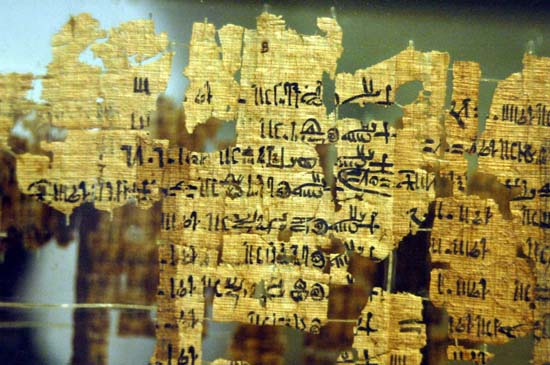
The Royal Canon of Turin (Gardiner 1959) (Fig. 3) is a hieratic papyrus found in Luxor in 1820 and sold to the Egyptian Museum of Turin in 1824, after a trip that badly damaged and deprived it of the initial and final parts. Dating back, almost certainly, to the time of Ramses II (XIII century BC), it lists the nineteen dynasties that preceded its compilation.
The interesting thing about the list is that it is not written on the recto of the papyrus, but on its verso. The recto contains the list of taxable resources of people and institutions; thus, originally the papyrus was an administrative document, probably used for tax purposes (Ryholt 2005). It is likely that, once it became obsolete, its back was then used to write the king list. This detail makes it remarkable: unlike the temples inscriptions, which had clear promotional purposes, the papyrus of Turin had not an explicit propaganda goal. A proof of this is the mention of the foreign conquerors Hiksos, inserted at the time of their rule over Egypt, a reference otherwise systematically absent on the temples. In other words, the list seems to be some sort of memo, maybe for officials or priests, to be used for composing official histories or calendars of events, a purpose that gives the Canon of Turin a historical objectivity that other public inscriptions do not have.
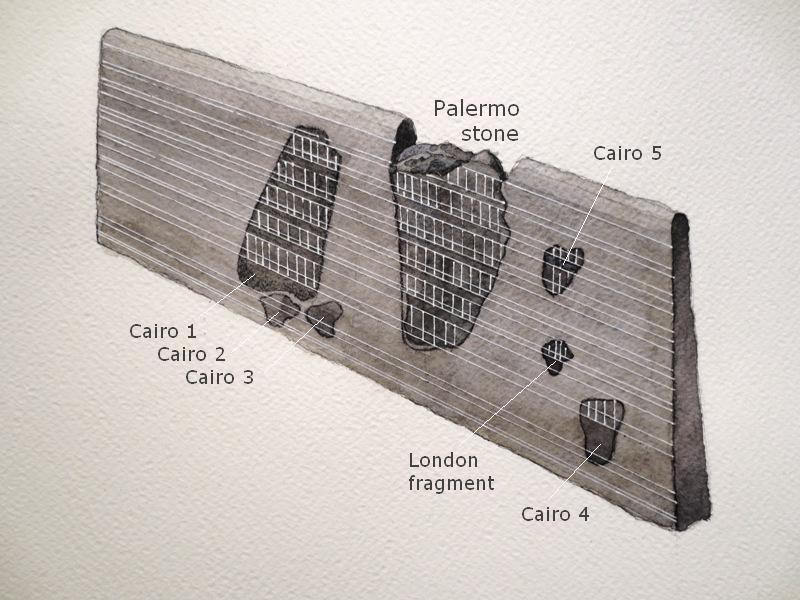
The most important document for the early history of Egypt is the Palermo Stone (Hsu 2010), the largest and most readable fragment of seven, all apparently belonging to the same stele. The stele, known as the Royal Annals of Ancient Egypt (Wilkinson 2000), was probably a single stone two meters long and a half meter high (Fig. 4), placed in an unidentified temple during the Fifth Dynasty (ca. XXIII century BC), which reported year by year, along eight rows engraved on it, the height of the Nile flood and the events to be remembered. The rows are composed of rectangular boxes, whose widths vary little along the same row, but much from a row to another (Fig. 5). The annals of the fourth and fifth dynasty, closer to the time of the recording, show larger boxes and a greater wealth of detail than the first three. Like the list of Turin, the Royal Annals include all previous
dynasties preceding their making and seem to have had a practical rather than an apologetical function. The annual registration of important events and the height of the Nile flood (which determined the incidence of taxation), suggests also in this case an administrative or religious purpose.
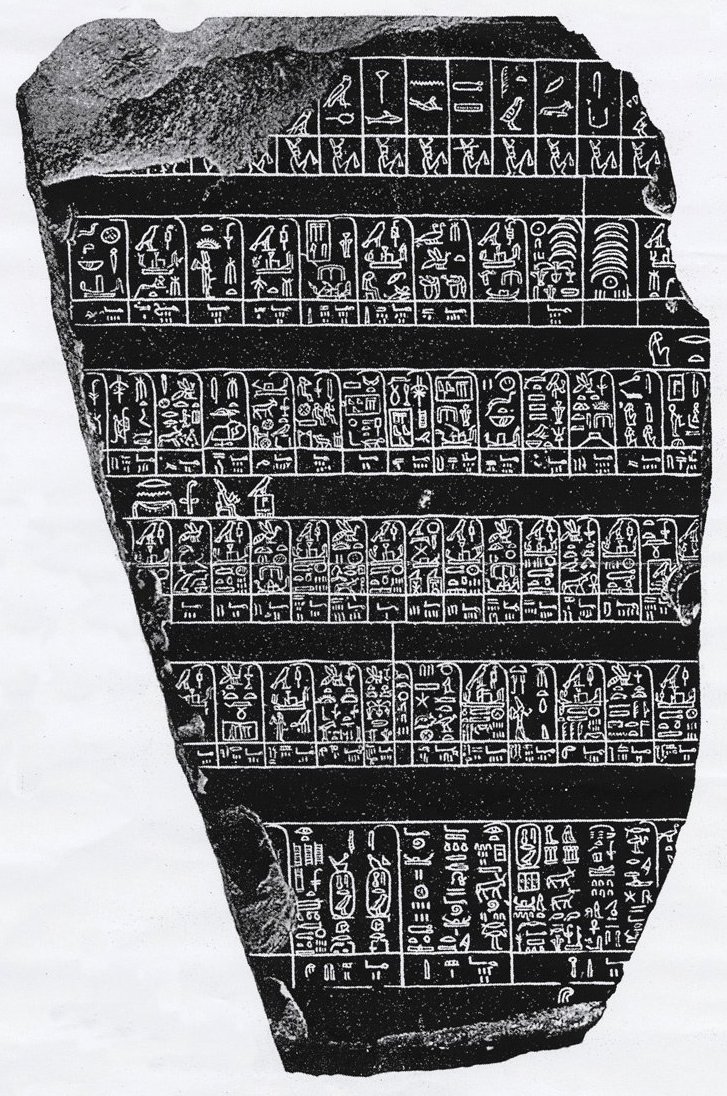
The Annals too, as the Aigyptiaka, show a long series of pre-unitary kings, whose alleged
number, obtained dividing the length of the stele by the width of the boxes, would push the pre-dynastic period at least a thousand years earlier than currently estimated. Note that the first kings were Gods also according to the Royal Annals. The seven fragments have been translated, interpreted and reinterpreted by generations of Egyptologists in the hope, so far unsuccessful, to shed light on the early Egyptian history.
From the brief and rough analysis made so far, it is clear that the Egyptians believed that their origin dated back to several millennia before the dynastic period, in line with Herodotus’ citation of the 341 hereditary piromis of the temple of Zeus, which, with an average generation gap of twenty-five years would have pushed the foundation of Thebes to around 8,500 BC. The date proposed by Plato for Atlantis was therefore perfectly in line with the Egyptian chronology of his time (the hypothesis to shorten it by ten times would have had the effect of rendering the story far-fetched to the eyes of his contemporaries.
It seems equally clear that, according to the Egyptians, their civilization followed the arrival of foreigners endowed with magic powers (a polite way to describe a conquest by more technologically advanced strangers). Plato’s legend of the Atlantean invasion of Egypt could therefore simply derive from the myth of the birth of the Egyptian civilization, a “gift” from the divine founders coming from West.
The real incongruity is the time gap between this traditional date and the one credited by historians, for whom the pre-dynastic period began only eight thousand years ago (and the royal one just six thousand). A three thousand years gap is not negligible. To silence the detractors of the “official science”, often inclined to believe the ancient legends and to overstate the remoteness of antique civilizations, let us have a look to the archaeological findings that support modern historiography.
The Egyptian prehistory. Egypt has been inhabited for long time. The remains of numerous Palaeolithic industries show that it was already steadily occupied five hundred thousand years ago, but it is likely that the region had been visited by hominids even earlier.
In Egypt the late Palaeolithic ended about twelve thousand years ago; in the region the conventionally accepted sequence of the different phases is the following (K. A. Bard 1999, p. xxvii):
Lower Palaeolithic c. 500,000-200,000 BP (Before Present)
Middle Palaeolithic 200,000-45,000 BP
Upper Palaeolithic 35,000-21,000 BP
Late Palaeolithic 21,000-12,000 BP
As in many regions of the northern emisphere, also the Egyptian Palaeolithic was marked by the transition from the ice age to the interglacial period. While along the coast the drive was obviously the displacement of the shoreline, in the interior it was the alternation between dry and wet periods to force modifications to the living habits.
Temperature changes had not trivial consequences on the humidity of the Sahara. In fact, they modified the temperature and pressure gradients with the result that, for long periods, the humid winds from the Indian Ocean managed to reach the desert and water it with rain. To simulate how far the monsoons could penetrate in the past, scientists have developed climate models, which, taking into account a number of experimental data (e. g. the presence of particular pollens in different sediment layers), have reconstructed the wind patterns over the centuries.
These models have confirmed what was already supported by the geological, palaeobotanic, palaeo-zoological evidence and by the numerous rock paintings found in desert areas today uninhabitable: the climate of the Sahara has been really characterized by the alternation of dry and wet periods (and will probably do the same in the future).
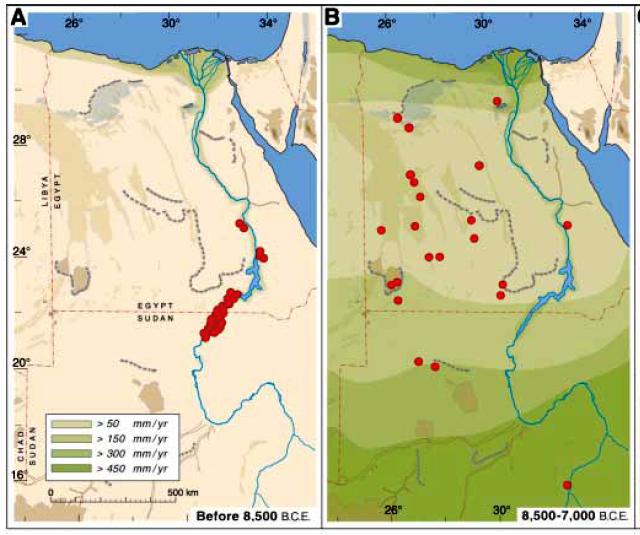
During the late Palaeolithic, we know, for example, that around the Last Glacial Maximum
(LGM) it was dry roughly as today (Gasse 2000). Then, as now, life in Egypt would have been concentrated along the Nile and on the coast. A clear indication of this is provided by Fig. 6A showing Palaeolithic sites from 22,000 to 10,500 BP. The sites thicken along a stretch of the Nile, but are absent both on the coast, and on the delta of the river. Why? Did not the ancient Egyptians, unlike their contemporaries, enjoy living by the sea or on the most fertile territories? Not necessarily, recalling that the ancient coastline is today offshore (we should have looked for sites underwater) and noting two things:
a) The structure of today’s Nile delta is not the same of eleven thousand years ago: many branches of the river have changed position.
b) Usually in the Nile delta archaeologists avoid to dig layers deeper than those corresponding to about 7,000 years ago, because they get flooded almost immediately.
In practice, the absence of late Palaeolithic sites along today’s coast and in the Nile delta
might not be ascribed to the lack of ancient inhabitants, but, more probably, to the improper search of the sites. [24]
10,500 years ago (corresponding to 8,500 BC) things changed. The monsoons were able
to penetrate the desert and most of Egypt turned into a savannah, with hills covered with shrubs and even trees (Ritchie and Haynes 1987). Its depressions hosted a large number of lakes, even some huge ones, and its valleys were crossed by large wadis flowing into the Nile from the west. The Nile grew in flow, but also in irregularity, due to the torrential character of these wadis. Its floods became more extensive and unpredictable and its wetlands extremely vast.
Living along the river became difficult, it was much simpler to stay in the oases around
the lakes, taking advantage of easy hunting and, perhaps, of pastoralism. In fact, Fig. 6.B shows the vanishing of sites along the Nile and the appearance of new sites in today’s desert, distant enough from one another to suggest independent communities.
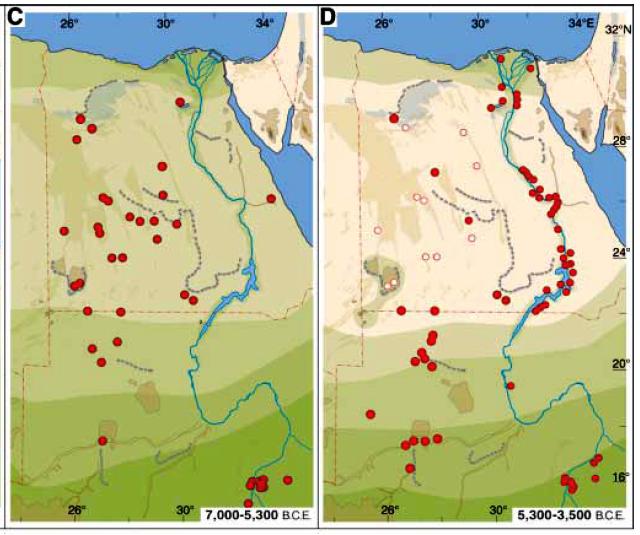
The humid period lasted up to 7,300 years ago (5,300 BC) while the occupation of the
“desert” became more and more stable, probably favoured by sheep farming, whereas the banks of the Nile remained still largely uninhabited (see Fig. 7.C).
But 7,300 years ago the savannah started desertifying again and another exodus began.
The northern regions were abandoned more quickly, while the south, towards Sudan, maintained some residual moisture and continued to harbour life. The Nile, reduced in flow but more regular, became the only source of water in northern Egypt. The attraction exerted was irresistible and many tribes, which for millennia had lived apart, were forced to come into contact. Contacts might have not been idyllic, but had to be. For historians this phase coincides with the start of the pre-dynastic period. Over the following 1,700 years the progressive desertification turned the Nile in the sole source of life, all tribes settled on its banks and ended up grouped into two kingdoms.
The earliest sites found in the river delta date to this period (Fig. 7.D). As mentioned
before, this antiquity is essentially dictated by technical reasons: in the delta excavations “deeper” than seven/eight thousand years ago are avoided because, being the corresponding quotes well below the river level, they become flooded almost immediately. Put yourself in the shoes of an archaeologist: with all the good stuff you have already found in the upper layers, would you spend precious time digging further, while your colleagues publish?
As a consequence, the deduction that the delta was not inhabited before seven thousand years ago is not correct. In fact, the opposite is probably true. Kuper and Kröpelin (2006) have catalogued about five hundred 14C datings, collected in 150 prehistoric sites throughout Egypt, and have ordered them from north to south (Fig. 8).
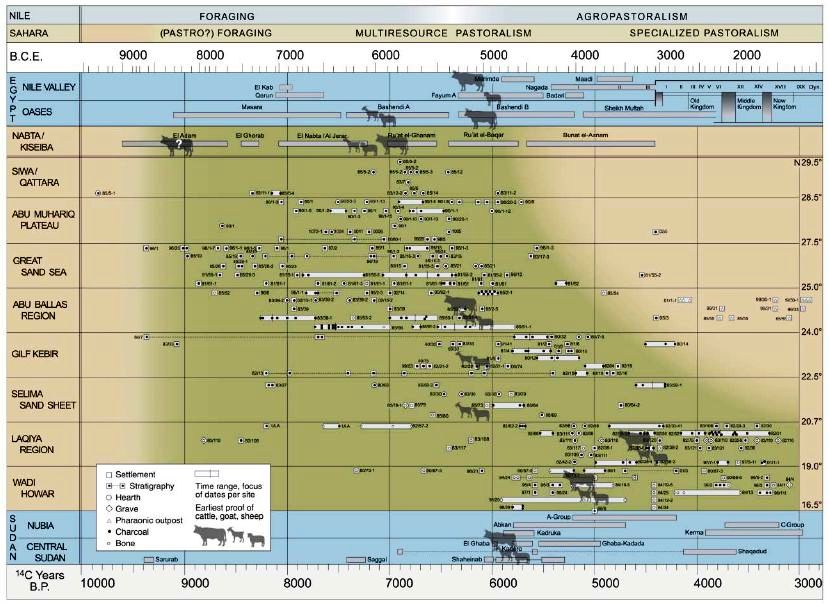
The striking thing is the diagonal pattern of the findings. That is, as time went on,
settlements and technologies spread from north to south. However, in the top left corner, the cloud of findings rarefies and disappears: in the delta and on the coast there are no finds before eight thousand years ago. But we know why: no one has actually searched them! On the other hand, the probability that the coast and the delta were really uninhabited at the end of the Palaeolithic is not too high: it would have gone against a housing trend that had very few exceptions over the millennia, all of them justified by concrete reasons.
Although we have looked for archaeological data to disprove the extreme remoteness
claimed by the ancient Egyptians, we have not reached conclusive evidence for the regions of the delta and of the coast. Actually, although the birth of the pre-dynastic period coincided with the forced grouping of the tribes along the Nile, providing a solid foundation for its dating, we must admit that, with respect to northern Egypt, we just lack the data. Moreover the Mediterranean coast and the Nile delta were the contact areas with the “fertile crescent” where, in the same period, agriculture was being born and the technological innovations of the Middle East were appearing.
Being the land closer to the sources of innovation and, at the same time, the one through
which innovations spread to the rest of Egypt (the diagonal cloud), may be not enough to draw a decisive conclusion, but the suspicion that someone not only lived there, but was also aware of the new agricultural, building and maritime techniques then appearing in the near East is strong. In fact we could not even rule out that the Palestinian innovations were actually born on the Nile banks and spread in the Middle East from there. It is a hypothesis beyond the archaeological licit, quoted only because that was exactly the traditional time of the divine conquest of Egypt, which brought there all its new technologies.
In conclusion: at the time of the alleged invasion of Atlantis, Egypt was inhabited and was emerging from the Palaeolithic. No artefacts from that period have been found along the northern Mediterranean coast and in the Nile delta (the areas that might have more easily come into contact with possible sea conquerors), but they have not been properly searched. On the other hand, the chronological picture of the overall Egyptian findings suggests that the civilization did spread from north to south. In other words, while the absence of archaeological finds cannot prove that the Nile delta was not inhabited at the time of Atlantis, the distribution of findings in the rest of Egypt suggests that it should have been (Fig. 9)
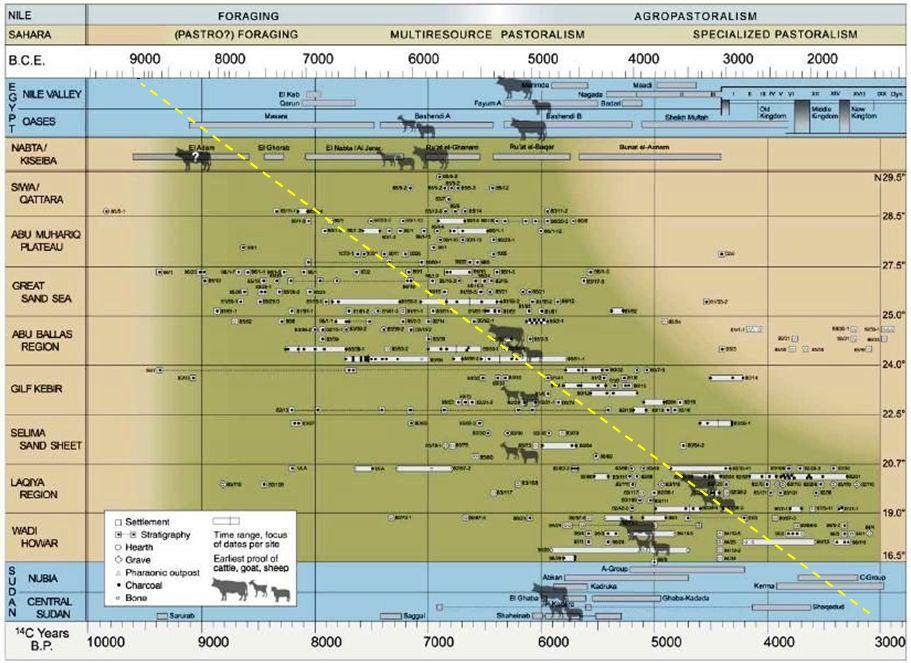
Top of the page
Return to the main article
In 2018 this site has been accessed times;
Atlantis has been visited times.